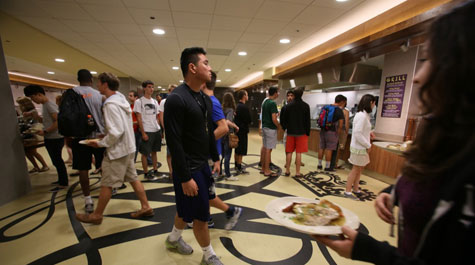W&M eliminates single-use plastics in dining halls
Straws get a lot of attention as food purveyors look to eliminate single-use plastics, and they were among the items to go as William & Mary Dining Services said goodbye to plastic in 2019.
As part of the university’s ongoing sustainability efforts, Dining implemented a phase-out to use up its remaining stock on the way to using new alternatives, according to Stephen Moyer, W&M Sadler Center Court operation manager. Also recently, Dining became certified by the Green Restaurant Association.
“Single-use plastics were eliminated in Commons and Sadler Center Court,” Moyer said.
W&M’s Sustainability Plan, a five-year plan that started in 2019, included a commitment in its diversion section to eliminating the distribution of single-use plastics in the two dining halls by 2019.
“Plastic waste has permeated the world around us, and we are taking steps to reduce the creation of that waste on campus,” said W&M Director of Sustainability Calandra Waters Lake. “Even more impactful than recycling, the rethinking and reducing that dining has done through this initiative sets an example that we hope to continue to expand.”
She added that the majority of the Sustainability Plan is on track, with some initiatives running ahead of schedule.
“The recent setting of a 2030 carbon neutrality date has been finalized a year in advance, with the Climate Action Plan on track for a 2020 launch,” Waters Lake said. “Additional progress includes Procurement’s adoption of recycled content paper as W&M’s preferred choice, and the Green Fee funding of on-site solar projects with the Keck Lab and Facilities Management. Community Engagement’s sustainability-themed 7 Generations pre-orientation program included local service, as well as the making of T-shirt bags for the food pantry FISH.”
Moyer said attention to limiting use of plastics in dining started a couple of years ago when the harmfulness of plastic in oceans started to gain attention.
“So as we started to do that, one of the first things we did was to try to take a look at everything that was out in the dining hall that was single-use plastic,” Moyer said. “Resident dining halls are a little easier because typically you have reusable plates and silverware. Just taking stock in everything we had, we really didn’t have a lot of things that we needed to get rid of.”
Small changes such as swapping reusable metal or compostable cups for plastic cups at omelette and waffle stations were quick and easy. Compostable cups for takeout smoothies were phased in as well. Plastic cups for jelly, butter and cream cheese were switched for larger bulk containers made out of different materials.
Straws are not out for the taking and haven’t been missed, Moyer said.
“The biggest thing was the straws,” he said. “Now I thought at first eliminating straws may be difficult with students, but we haven’t had any pushback. We do offer some straws only for medical necessity.”
Compostable cutlery kits are available for take-out.
“I think it’s a great accomplishment,” Moyer said. “For us, it was a lot easier to do than maybe others who are just starting sustainability because we’ve always looked at ways where we can eliminate items before they even get out front.”
Dining Services composts all food waste, which Moyer said includes about three-fourths of all trash it disposes of.
“I think it’s something to be applauded and shared,” Moyer said. “As the company Sodexo and as a school, we’re really looking toward reducing our carbon footprint.”
The next step is to continue to work on the retail side in Marketplace and with national brands on campus such as Chick-fil-A and Starbucks as they implement sustainability efforts.
“That’s a little further away, but still something that we’re continuing to monitor and talk about to try to get our partners to do the same,” Moyer said.
The Green Restaurant Association evaluated all aspects of W&M Dining as part of its recent certification. The process included examining the environmental practices of the entire operation including what’s bought locally, how much is composted and what types of vendors are used. It covered the two dining halls, catering department and Marketplace, which is the largest retail outlet.
W&M got points for serving meat-free dishes that support plant-based diets, for example. Another plus was cooking oil being reused for biofuel.
“We’re in a national database now, so any prospective student can see that William & Mary is certified,” Moyer said. “It’s really popular within the sustainability community because it’s more of a holistic approach. It’s not just food or energy or water consumption; it’s kind of a little bit of everything.”
 Skip to main content
Skip to main content

